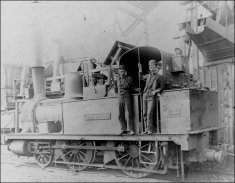At one time, Sydney Mines was called "Lazytown." A map of 1863 actually showed the area as "Lazytown". This less than flattering name came from local farmers who would arrive in town in the morning to find a few people up and about. This was due to the shift work employed by the local mines. The coal miners and their wives would wake at dawn and get ready for the day shift. After the men went off to the pits, the wives would return to bed for some extra sleep. No one was awake to greet the farmers coming to sell their milk, eggs and produce. Sydney Mines grew up around the rich coal fields of Sydney Harbor and one pit - Princess Colliery - operated continuously for 100 years, from 1875 to 1975. In that time, Princess produced 30 million tonnes of coal. The first mining took place in 1766 along the exposed seams of the harbour cliffs. When the General Mining Association took over Cape Breton coal mining in 1827, the area was simply known as "The Mines." Sydney Mines' first house, owned by R. Brown, dates from this era (1829) and still stands at 32 Brown St. By the turn of the century, Sydney Mines was one of the top coal producing communities in North America. Workers came from Italy, Poland, Germany, Lithuania, Austria, England, Scotland and Wales to work in the mines. A steel plant opened in 1902 and much of the town's infrastructure - sewer, water, electricity, paved streets - was established at that time. In 1932, Sydney Mines' population peaked at 10, 000. There are no coal mines operating in the town today, but many of the workers at nearby Prince Mine at Point Aconi live in Sydney Mines. The town has downtown shopping area with grocery stores, pharmacy, bakery, banks, restaurants, service stations, town police and library. A sport's complex on Brown St. has ballfields and tennis courts. There is an undeveloped beach at the end of MacLean St. fronting Sydney Harbor. A miners' monument located on Main St., pays tribute to the men who perished at the local collieries, including 22 miners who were killed by a runaway man-rake (train) in 1938. The town's most visible artifact is a red, sandstone town hall, built on a downtown corner in 1904 as a federal post office. The building was renovated in 1989 and registered as a provincial heritage property. Another Sydney Mines landmark is Gowrie House, a two-storey, wooden mansion on Shore Rd., overlooking the harbor, built in 1834 by Samuel Archibald whose family and descendants maintained residence for a century and a half. Marble fireplaces, extensive grounds and outbuildings reflected the prosperity of the family. Gowrie House is now a four-star country inn, offering accommodations and gourmet meals year-round. In 1990, international recording artist and performer Rita MacNeil filmed a television special at Gowrie House. Some other popular sites in Sydney Mines include: Annondale: This charming estate was built in the early 1880s by Lewis Johnston, who modeled it on a similair house his family owned in Wolfville. The Wolfville property no longer exists, but this lovely house bears its name. It remained in the hands of Johnston descendants until 1936. It is still a private home. MacCormick Home: This magestic structure overlooking the harbor was built in 1853. It served as the office building of the General Mining Association until 1900, when a new office was built on Pitt Street. For a while the old office served as a meeting place for the Rotary Club of Sydney Mines. It is now a private dwelling. Town Hall: The town hall, located on Fraser Avenue, was built in 1904. It served as a post office and was later restored to preserve its unique architectural design. St. Andrew's Presbyterian Church: Many of the workmen imported by the General Mining Association were Presbyterian Scots. By 1785, Presbyterian ministers were making regular visits to town. In 1884, the first church was built and the first permanent pastor appointed. The new church was built in 1904. Cenotaph: In World Wars I and II, the enlistment rate in Sydney mines was so high (approximately seventy-two percent) that military authorities finally had to refuse to accept men who were employed in the collieries. The cenotaph honours residents who died in the world wars and the Korean conflict. Immaculate Conception Roman Catholic Church: The first church in Sydney Mines was a Roman Catholic log chapel, built in 1823. In 1838...

|
Sydney Mines, Nova Scotia City Mouse Pad Office Product (Custom Image Factory)
|
Related video



|
C. N. R. Station, Sydney Mines Cape Breton, Nova Scotia Original Vintage Postcard Entertainment Memorabilia (Photogelatine Engraving Co.)
|

|
Sydney Mines, Nova Scotia City White Stainless Steel Mug Kitchen (Custom Image Factory)
|





